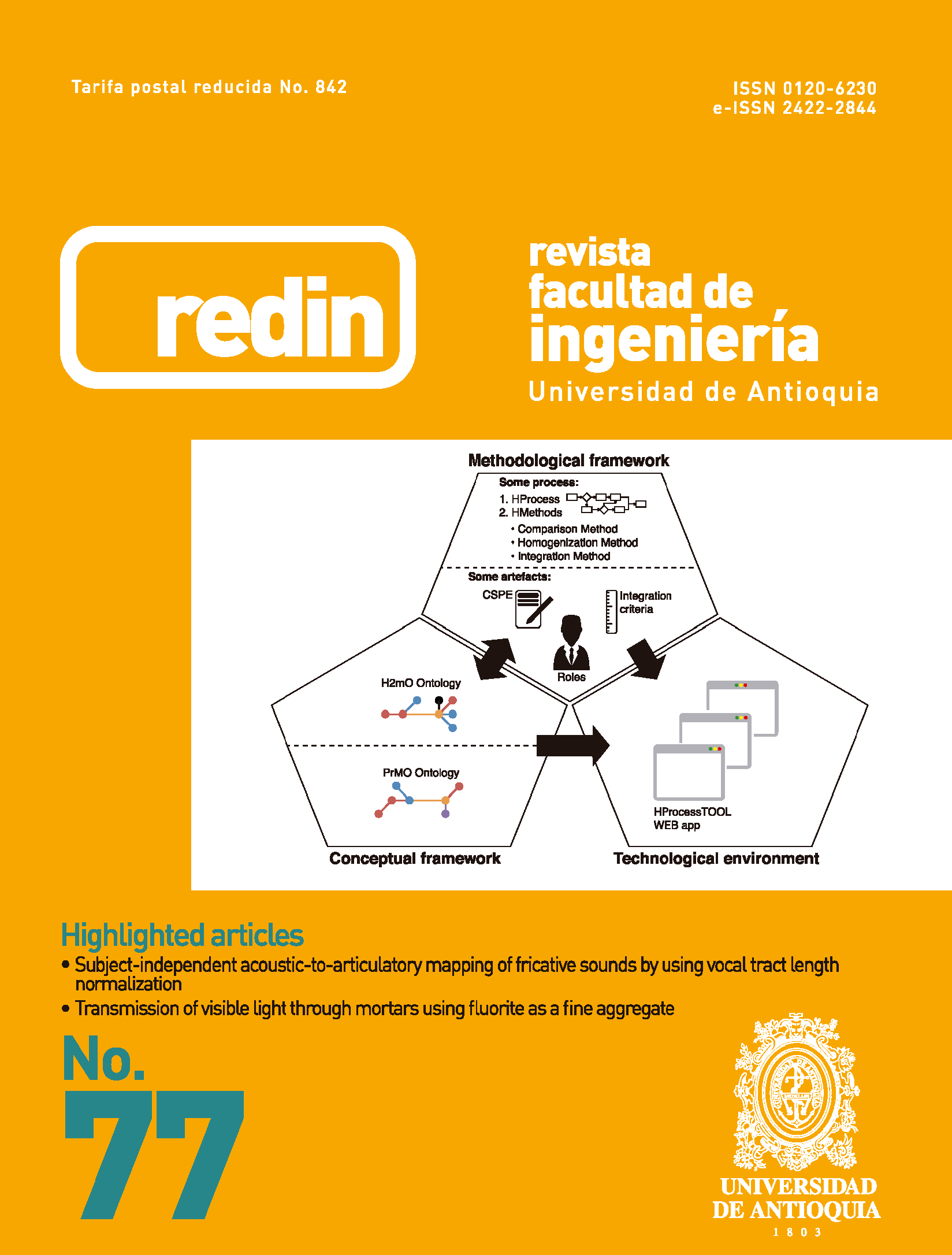Capacidad de absorción de energía de mallas de metal expandido sometidas a tensión
DOI:
https://doi.org/10.17533/udea.redin.n77a07Palabras clave:
tratamiento térmico, respuesta estructural, fuerza de tracción, absorción de energía, metal expandidoResumen
Los componentes metálicos usados para absorber energía deben ser capaces de absorber la energía de diferentes maneras dependiendo del tipo de las cargas aplicadas, es decir, compresión axial, fl exión, corte o fuerzas de tracción, o una combinación de éstas. Se espera siempre una respuesta estable a través de todo el proceso de deformación; sin embargo, esto depende esencialmente de parámetros geométricos como la longitud y la sección transversal, así como de las propiedades del material. Las mallas de metal expandido se fabrican mediante la expansión parcial en línea de láminas metálicas, creando una malla con aberturas formadas por venas y nodos, una confi guración geométrica que puede ser aprovechada en sistemas que absorban energía. Este trabajo presenta un estudio experimental sobre la respuesta estructural de mallas de metal expandido (estándar y aplanadas) sometidas a fuerzas de tracción. El estudio también analiza la infl uencia del tratamiento térmico de recocido sobre el comportamiento mecánico de las mallas de metal expandido. Los resultados muestran que las mallas aplanadas son capaces de absorber más energía que los estándares. Además, se observa que las mallas estándares son más sensibles que las mallas aplanadas, en términos de la respuesta estructural a los tratamientos térmicos.
Descargas
Citas
D. Smith, C. Graciano and G. Martínez, “Recent patents on expanded metal”, Recent Patents on Materials Science, vol. 2, pp. 209-225, 2009.
National Association of Architectural Metal Manufacturers (NAAMM), Standards for expanded metal, Standard EMMA 557-12, 2012.
G. Kooistra and H. Wadley, “Lattice truss structures from expanded metal sheet”, Materials & Design, vol. 5, no. 2, pp. 507-514, 2007.
P. Dung and A. Plumier, “Behaviour of expanded metal panels under shear loading”, in International Colloquium Stability and Ductility of Steel Structures (SDSS’Rio), Rio de Janeiro, Brazil, 2010, pp. 1101-1108.
P. Dung, “Seismically retrofitting and upgrading RC-MRF by using expanded metal panels”, Ph.D. dissertation, University of Liege, Liege, Belgium, 2011.
M. Rambo, P. Mtenga and K. Walsh, “Missile impact resistance of a metal mesh roofing system”, Journal of Architectural Engineering, vol. 18, no. 3, pp. 199-205, 2012.
C. Graciano, G. Martínez and D. Smith, “Experimental investigation on the axial collapse of expanded metal tubes”, Thin-Walled Structures, vol. 47, no. 8-9, pp. 953- 961, 2009.
C. Graciano, G. Martínez and A. Gutiérrez, “Failure mechanism of expanded metal tubes under axial crushing”, Thin-Walled Structures, vol. 51, pp. 20-24, 2012.
G. Martínez, C. Graciano and P. Teixeira, “Energy absorption of axially crushed expanded metal tubes”, Thin-Walled Structures, vol. 71, pp. 134-146, 2013.
D. Smith, C. Graciano, G. Martínez and P Teixeira, “Axial crushing of flattened expanded metal tubes”, Thin-Walled Structures, vol. 85, pp. 42-49, 2014.
D. Smith, C. Graciano and G. Martínez, “Quasi-static axial compression of concentric expanded metal tubes”, Thin-Walled Structures, vol. 84, pp. 170-176, 2014.
G. Martínez, C. Graciano, E. Casanova and O. Pelliccioni, “Estudio del comportamiento estructural de mallas de metal expandido sometidas a tracción”, Boletín Técnico IMME, vol. 46, no. 2, pp. 37-52, 2008.
D. Smith, C. Graciano and G. Aparicio, “An empirical method for the estimation of yield strength on bonds and strands of expanded metal meshes”, Rev. Fac. Ing. Univ. Antioquia, no. 74, pp. 132-142, 2015.
G. Box, J. Hunter and W. Hunter, Statistics for experimenters: Design, Innovation and Discovery, 2nd ed. New Jersey, USA: Wiley, 2005.
American Society for Testing and Materials (ASTM International), Standard Test Methods for Tension Testing of Metallic Materials, Standard ASTM E 8M-04, 2004.
Universidad Nacional Experimental Francisco de Miranda, Manual de Funcionamiento de la Máquina Universal de Ensayos Mecánicos PAGE WILSON MEASUREMENT SYSTEMS MODELO 60HD SERIAL 826936. Punto Fijo, Venezuela: CITEC-UNEFM, 2003.
Descargas
Publicado
Cómo citar
Número
Sección
Licencia
Derechos de autor 2015 Revista Facultad de Ingeniería Universidad de Antioquia

Esta obra está bajo una licencia internacional Creative Commons Atribución-NoComercial-CompartirIgual 4.0.
Los artículos disponibles en la Revista Facultad de Ingeniería, Universidad de Antioquia están bajo la licencia Creative Commons Attribution BY-NC-SA 4.0.
Eres libre de:
Compartir — copiar y redistribuir el material en cualquier medio o formato
Adaptar : remezclar, transformar y construir sobre el material.
Bajo los siguientes términos:
Reconocimiento : debe otorgar el crédito correspondiente , proporcionar un enlace a la licencia e indicar si se realizaron cambios . Puede hacerlo de cualquier manera razonable, pero no de ninguna manera que sugiera que el licenciante lo respalda a usted o su uso.
No comercial : no puede utilizar el material con fines comerciales .
Compartir igual : si remezcla, transforma o construye a partir del material, debe distribuir sus contribuciones bajo la misma licencia que el original.
El material publicado por la revista puede ser distribuido, copiado y exhibido por terceros si se dan los respectivos créditos a la revista, sin ningún costo. No se puede obtener ningún beneficio comercial y las obras derivadas tienen que estar bajo los mismos términos de licencia que el trabajo original.










 Twitter
Twitter